Let’s talk basal insulin.
Basal insulin comes in two forms, both have the same purpose: to transfer glucose pushed out by the liver into body cells to create energy. This picture shows the speed at which glucose enters the blood from the liver changes across the day.

The first type of basal insulin is long-acting insulin delivered by injection. Long-acting insulin works evenly over twenty-four hours, and there are many different ones: Lantus, Levimer, Degludec, Tresiba, etc. Before going onto a pump, I used 12 units of Levimer, which worked at roughly 0.5 units per hour.
The picture above shows that there can be a mismatch between the action of basal insulin by injections and liver glucose output. My glucose would sometimes increase overnight and drop during the day due to this misalignment. This is why I moved to an insulin pump.
The second type of basal insulin is delivered by a pump using fast-acting insulin. The pump delivers an hourly basal rate that can be changed to match the liver’s glucose output.
The current fast-acting insulins used in pumps are NovoRapid, Humalog, Apidra, FiAsp, and Lumjev. I use FiAsp in a Medtronic VEO pump and have five time-blocks with different hourly rates to better match the glucose output from my liver. The total amount of basal insulin is still about 18 units, but it’s delivered:
00:00 – 03:00 = 0.75 units per hour
03:00 – 09:00 = 0.80 units per hour
09:00 – 14:00 = 0.5 units per hour
14:00 – 20:00 = 0.7 units per hour
20:00 – 24:00 – 0.75 units per hour
I have had fewer highs and lows overnight since pumping, which makes being attached to a little machine tolerable. But only just!
Grace and Jude, a pump might not suit you. If not, it will not be a problem, there are lots of ways to combat the mismatch. We could spit the basal injection into two. We could start with 60% before bed and 40% on waking. We would certainly need to do some trial and error and tinker regularly.
How do I know if basal insulin is set correctly?
The simple answer is to have your last meal at 18:00 and see what happens to the glucose overnight. By having the last meal at 18:00, all fast-acting insulin will be out of your system by 23:00.
If the glucose does not rise or fall more than 2.0mmol/L (36mg/dL) overnight, it’s bang on!
If the glucose rises more than 2.0mmol/L (36mg/dL) overnight, the basal insulin needs increasing 10-20%.
If the glucose drops more than 2.0mmol/L (36mg/dL) overnight, the basal insulin needs reducing 10-20%.
This picture explains it much better.
If only it were this simple. I have painted a far too simplistic picture. The amount of glucose the liver pushes out changes from night to night, depending on the day’s events. For example:
- Liver glucose output will be higher than normal after a very high-fat evening meal – Pizza taught me this.
- Liver glucose output will be lower than usual on exercise days – More on this in the Exercise section.
- Liver glucose output will be minimal after a night of heavy alcohol intake. From 2008 to 2017, I acquired a significant amount of experience in how to combat this. You will be able to read about this in the partying with type 1 diabetes section that is in development.
This is why a CGM with alarms will be your guardian angel. Although it will annoy you from time to time by disrupting your sleep.
The best way to manage the liver glucose output overnight is to change the basal rate as the glucose level changes. That is exactly what automated pancreas systems do. These systems track the change in glucose and speed up or slow down the basal rate accordingly.
Automated Insulin Delivery (AID) Systems are the bee’s knees overnight. I benefitted immediately when I trialed DIY looping, T-Slim x 2 with Control IQ, Omnipod 5, and the MinMed 780G. This graphic explains the overnight issue and how one of the automated pancreas systems, CAMS APS FX, dominates.
I created an AID System Guide for those who want to know more.
Why did I say automated pancreas systems dominate overnight and not all day?
This is where it gets interesting!
AID Systems react to the changing glucose level by increasing or decreasing the speed of insulin delivery. This works perfectly when the glucose level is moving slowly and there is no food, mealtime insulin, exercise or stress to deal with.
When’s that?
Overnight!
What about during the day?
The picture below shows how ineffective a basal rate reduction is when the glucose is dropping quickly following mealtime insulin that was too much. The basal rate reduction takes ages to get going and only starts to make a difference an hour after being started. Meanwhile, the glucose continues to dro,p and a nasty hypo occurs unless you swallow some glucose.
To make matters worse, the glucose rises rapidly after the usual hypotreatment.
Why?
The temp basal decease has caused a lack of circulating insulin, causing a nasty high glucose hangover.
This is just like shutting the stable door after the horse has bolted!
Remember this: Insulin is a SLOW mover of glucose.
During the day, you will need something that brings the glucose up in 20 minutes.
The next graphic shows how useless a basal rate increase is when the glucose is rising quickly following mealtime insulin that was too little. The basal rate increase takes forever to kick in and only gets the glucose back into target after three hours.
Again, Insulin is a SLOW mover of glucose.
During the day, you will need something that drops the glucose much faster.
Next Step? Bolus Insulin.